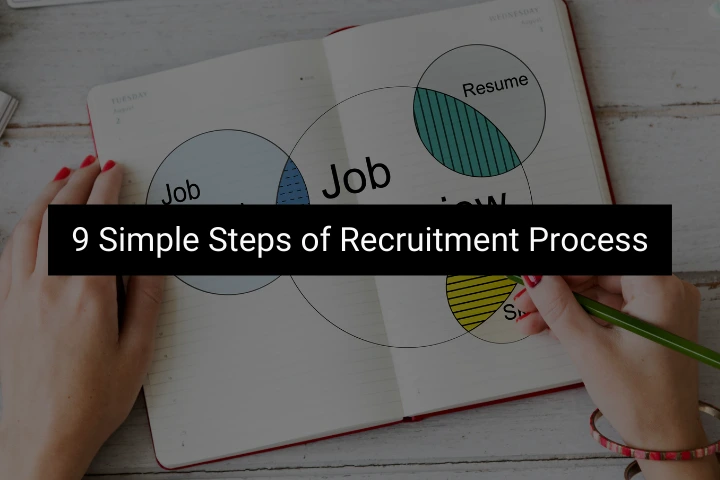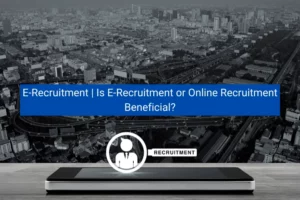What is Recruitment Process?
Recruitment is a process of identifying and attracting potential employees to fill open positions in a company. Identifies applicants with the skills and attitudes needed to help the business achieve its goals.

The recruitment process includes job opening, job description, pay, advertising the position, screening process, interviewing questions, list of interviewees, reference timing, and decision time.
It is advised that an organization's HR personnel follow the nine best practices to boost hiring efficiency. These nine steps will ensure that your recruitment process runs smoothly. Furthermore, these procedures ensure that the recruitment process is consistent and compliant.
The process of recruiting is the first stage in building a strong resource base. Starting with locating resources, arranging and conducting interviews, and finally selecting the best individuals, the process follows a systematic procedure.
How to Develop a Long-Term Recruitment Strategy? Click Here>>>
Steps of Recruitment Process
You are in charge of the department's day-to-day operations and are well-versed in its various business activities. What about the human resources tasks? Finding the proper personnel is the first step in managing staff.
I've put together a step-by-step guide to assist you to navigate the maze of recruiting the appropriate people.
1. Job Opening:
Decide if you or Human Resources are in charge of the recruiting process. HR is in charge of the procedure at some companies. In smaller businesses, the manager is often in charge of the entire process. Even though it's HR, you should be involved in many of the phases.
2. Job Description:
You'll need a job description whether you're filling a replacement or a brand-new post. Review or write a job description before beginning any outside recruiting attempts. If you're replacing a job, now's a good moment to think about how this person can best contribute to your department.
Global Digitization in Human Resource Click Here>>>
3. Pay:
Know how much your budget can take, or, if your organization has pay grades, what the range is for this position. Keep in mind a few things when thinking about this: the experience of the possible employee you're looking for, what others are earning for similar jobs, and what you can afford to meet your budget. If you have a human resources department, they can help you with this.
4. Advertising the position:
You can post your job opening on any of the online job boards, niche job boards or publications, newspapers, or local newspapers. Depending on the difficulties of identifying talent for the post or your time available throughout the search process, you may want to employ an outside recruiter. Internal candidates for the role should not be overlooked.
7 Risk Management Strategies in 2021 Click Here>>>
Another place to look for talent is among your present staff. When I was full-time recruiting, I was able to hire 34 percent of my new recruits through employee referrals. They can serve as talent scouts for you. Create an Employee Referral Program in which you reward the employee who finds top talent for you.
To aid in the gathering and sifting of resumes, several companies use Applicant Tracking Systems. If your organization has a lot of open roles, I strongly advise you to invest in a system.
Even if you don't have an applicant tracking system, you can utilize Microsoft Outlook to sort and file incoming resumes. You might be seeking a sales manager and a junior sales representative, for example. Make sure the subject line of your ad specifies either Sales Manager or June Sales Rep. With the right set up on your PC, each email with the resume will go into the relevant folder as soon as it arrives in your inbox.
What is Payroll Processing | 5 Basic Steps in Processing Payroll Click Here>>>
5. Screening Process:
Who is in charge of the initial screening of resumes? You, HR, or someone in your department who is knowledgeable about the type of individual you're looking for. They'll sift through the many resumes, using the job description as a guide, to find the top prospects.
If HR is doing the screening, they would normally provide you with their best resumes for you to review. They can even conduct preliminary interviews before you see the resumes. Then they offer you their best candidates.
Note: Make a list of "who does what" before you start recruiting so that everyone is on the same page and the process proceeds smoothly.
6. Interviewing Questions:
Consider what you'd like to learn about each of the contenders. Make a list of ten open-ended questions to ask each of the contenders.
Difference between Risk Mitigation and Risk Management Click Here>>>
open-ended inquiries Ensure that the applicant provides more than a simple "yes" or "no" response. If you're looking to fill a customer service role, for example, ask the candidate to "tell me about a time when you had to deal with a tough customer, what happened, how did you handle it, and was the customer satisfied or not."
Make a separate sheet for your interview questions, and keep track of the candidates' responses there. Keep the resume clean by not writing on it. If the candidate is interviewed by someone else, he or she will not be persuaded by your opinions. As a guide, give them your list of questions...without the answers.
7. Lists of Interviewees:
Make a list of potential interviewees and make them aware of their role in the hiring process. Individual 1:1 interviews or a group interviewing process are both options. You don't want the interviewing process to drag on due to schedule conflicts, so try to be organized. When we were actively recruiting, we had the unfortunate experience of losing a prospect due to a lengthy interviewing procedure.
Employee Engagement | Top 7 Activities of Employee Engagement Click Here>>>
8. Reference Checking:
Always double-check your references. There are certain companies that refuse to provide references, despite the fact that we inform the candidate that we want references that will speak with us about their performance. We ask them for a boss or two who has overseen them, as well as a peer who has worked alongside them. After that, develop a list of questions to ask the references. Prepare yourself to hear both what the references say and what they don't say.
9. Decision Time:
This is the time to collect everyone whom has interviewed the candidates and make a decision on who you will offer the post to and why.
For Human Resource, Payroll and many more HR Services, visit our website https://lingueeglobal.com/



